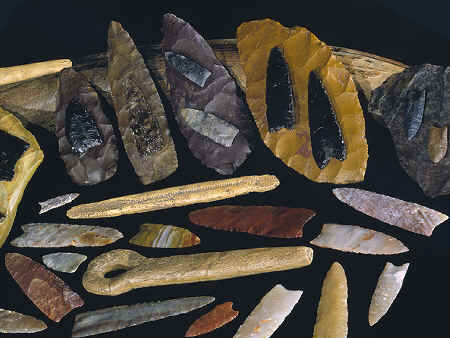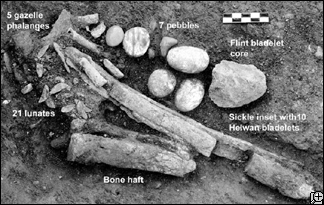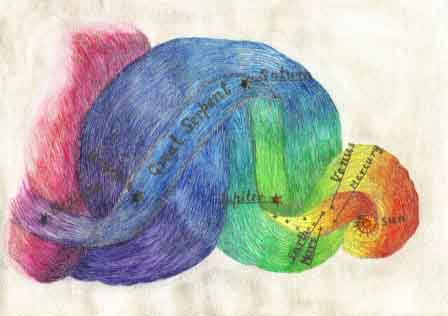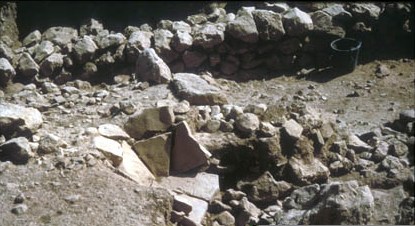Oahspe Study
Geophysical Records of Earth's Climate Changes
Periods and cycles of Light and Dark, which manifest both spiritually and
physically on the earth and it's atmospherea, are detailed in Oahspe. These
periods of spiritual light (when man turns to spiritual rather than material concerns) or darkness (when man focuses on the material world and loses sight of the spiritual) also co-incide with variations
in heat and cold and earth's climate. Evidence of such variations are recorded
in the geophysical records of the earth. These records are various geological registers such as
polar ice layers, C14 levels, dendochronology (tree ring layers), dust and ash
layering, etc. They are all indicators of variations in temperature and climactic
conditions of the geophysical history of the earth.
By comparing the geophysical data on dramatic climate variations around the times of the cycles of Apollo, Thor and Osiris, a correlation between the times of Light and Dark as given in Oahspe is found.
The Cycle of Apollo lasted 2,800 years around 18,360 to 15,560 years before present (BP).
The Cycle of Thor lasted 3,200 years around 15,560 to 12,360 years BP
The Cycle of Osiris lasted 3,300 years around 12,360 to 9,060 years BP
The dawn of a cycle generally co-incides with the highest light of a cycle also. And we find in Oahspe that Apollo's dawn not only co-incided with a time of light, but continued to be relatively light for about 2000 years. Comparing the beginning of Apollo's cycle with geophysical records of the earth, we find that it is marked by a warmer period in earth's climate that continued for another 1800 years:
|| Palynological, paleopedological, and glacial
geomorphological evidence from the area of the high plain of Bogota, in the
Colombian Eastern Cordillera indicates a significant climatic warming around
18,000 14C yr [Radiocarbon years] B.P. Comparison of dated vegetation changes,
pedogenic episodes, and glacier fluctuations provides the basis for defining
the so-called "La Laguna Interstadial" that lasted from 19,500 to
17,000 yr B.P. During this interstadial period, mean annual temperatures in the
tropical Andes were up to 4 degrees C higher than during the preceding and
following stadial periods, when full-glacial conditions prevailed and
temperatures were up to 8 degrees C colder than at present. || Abstract
from: Warming at 18,000 yr B.P. in the Tropical Andes By Karin F. Helmens July
1995.
From the above extract it is clear that round 17,000 years BP begins a cooling period which as we will see from the following extract, is soon followed by a warming period, these variations both coincide with the timelines of Apollo's and Thor's cycles in Oahspe. The cooling period comes less than a thousand years before the end of Apollo's cycle and the warming comes at the beginning of the cycle of Thor. This is consistent with the cycles of Light and Dark of an average 3,000 year cycle as given in Oahspe. The dawn, being the Hi-dan (most light) of a cycle gradually diminishes and recedes to a dark period lasting an average of a thousand years before a gradual rise in light starting about 400 to 600 years before the end of the cycle.
Oahspe reveals causes of the fluctuating conditions of light and dark, heat and cold manifested on the earth and atmospherea. These causes include the conditions of the space in which the earth travels and fluctuation's in the earth's vortex (one manifestation of the earth's vortex being its magnetosphere). The dust and ash from a comet or falling nebula in the form of meteorites can produce dramatic changes in the amount of light that reaches the earth and it's lower atmospherea. Researchers have also found evidence that earthquakes and volcanic eruptions have occured simultaneously with such celestial precipitations. And given the existence and potency of the vortex of the earth, such events can be understood to be related because the earth itself is subject to its vortex which penetrates to the core of the planet.
||....evidence of an elevated cosmic ray flux and
of a major interstellar dust incursion around 15,800 years B.P. suggest that a
cosmic ray wind driven incursion of interstellar dust and gas may have played a
key role through its activation of the Sun and alteration of light transmission
through the interplanetary medium....
Climate profiles from the British Isles and southern Chile both record a minor
warming event, prior to the Bolling [Cooling Period], spanning the period
15,750 to 14,850 cal years B.P. || Extract from: Evidence for a Global Warming
at the Termination I Boundary and Its Possible Cosmic Dust Cause By Paul A.
LaViolette
Oahspe describes a unique aspect at the beginning of Thor's cycle. That is, in this particular cycle, the usual period of 400-600 years of light that would follow the dawn of a typical cycle, begins with a 100 year period of "vocent", which is an external condition outside of the earth's atmospherea that would impinge upon and dramatically affect the atmosphere of the earth. It's effect on the spirit life in the atmospherea of the earth required the removal of dark spirits away from the earth's atmosphere, or else they would have been precipitated to the earth by the "vocent" shower. The geophysical record of the earth around this time shows large amounts of cosmic dust precipitated to the earth's surface at the same time that cosmic rays are intensified, corroborating that an unusual atmospheric event occurred that co-incided with those events described in Oahspe:
Book of Thor, 16/4.1-3.
|| In the fourth year of dawn under Thor, Son of Jehovih, he received from the
Holy Council in Buru, of Don'ga, in etherea, a dispensation from the Orian
Chiefs, decreeing to the earth one hundred years' travail in vocent.
Thor called up Waak, God of Rhines, and said to him: Jehovih has put a sore travail upon these heavens. Go to Hey'loo and command him to provide an avalanza sufficient to deliver twenty billion atmosphereans to the a'ji'an forests of Gonaya.
For the inhabitants of these heavens are too dark to endure the vocent of a hundred years, and would be precipitated to the earth and engage in fetalism.||
Continuing to demonstrate concordance with Oahspe's cyclic timelines, the following extract demonstrates that Geophysical records found in icecores and other geological registers point to a sudden warming period at the beginning of Thor's cycle (15,550 years b.p.) lasting 1000 to 1500 years:
|| Ice cores taken at the summit of Sajama mountain contained insects and bark that allowed carbon dating the deepest sample (130 m) at 24,000 to 25,000 BP. Oxygen isotopic ratios decreased between the early Holocene and the Last Glacial Maximum in agreement with other reported measurements. The abruptness (both in its beginning and ending) of a warming event between 15.5 and 14 ka [kilo annum, thousand years] BP suggest that the warming was caused by atmospheric processes. Sajama ice contains less than one-eighth the dust of polar cores despite the proximity of volcanoes, indicating greater precipitation in the tropics than at the poles; the low levels of dust during the Younger-Dryas period are similar to those in the Antarctic but unlike those in the Arctic, indicating that the elevated dust levels may have been a Northern Hemisphere phenomenon. || Extract from: A 25,000-Year Tropical Climate History from Bolivian Ice Cores, By L. G. Thompson et al., (Dec. 4, 1998).
The cycle of Thor ended with 600 years of darkness before the dawn of the cycle of Osiris which continued for 3300 years:
Book of Thor, 16/6.12-13.
|| Now the earth passes into deep darkness, for I fructify the races of men in
new corporeal growth, for things that shall come afterward. As they absorb from
the a'ji of My places, in this age, so, also, do their souls become full of
superstition and darkness. ||
Thus the earth went into great darkness during the last six hundred years of the cycle of Thor, and there was no harvest from her for the etherean heavens. But the spirits deserted atmospherea in millions upon millions, and went down to the earth, to dwell with mortals, and to find places to live on the corporeal earth.||
And again the geological evidence indicates that a sudden global cool period known as the "Younger Dryas Event" occurred around 12,900 years BP and lasted till around 11,500 years BP. The onset of this dramatic cooling period coincides directly with Oahspe's timeline of cycles, being 600 years before the end of Thor's cycle:
|
|| A carbon-rich black layer, dating to 12.9 ka, has been previously identified at 50 Clovis-age sites across North America and appears contemporaneous with the abrupt onset of Younger Dryas (YD) cooling. The in situ bones of extinct Pleistocene megafauna, along with Clovis tool assemblages, occur below this black layer but not within or above it. Causes for the extinctions, YD cooling, and termination of Clovis culture have long been controversial. In this paper, we provide evidence for an extraterrestrial (ET) impact event at 12.9 ka, which we hypothesize caused abrupt environmental changes that contributed to YD cooling, major ecological reorganization, broad-scale extinctions, and rapid human behavioral shifts at the end of the Clovis Period. Clovis-age sites in North American are overlain by a thin, discrete layer with varying peak abundances of (i) magnetic grains with iridium, (ii) magnetic microspherules, (iii) charcoal, (iv) soot, (v) carbon spherules, (vi) glass-like carbon containing nanodiamonds, and (vii) fullerenes with ET helium, all of which are evidence for an ET impact and associated biomass burning at 12.9 ka.
|
Clovis
Culture Artifacts of North America, 14,000 years b.p. Photo by Peter Bostrom
|
This layer also extends throughout at least 15 Carolina Bays, which are unique, elliptical depressions, oriented to the northwest across the Atlantic Coastal Plain.We propose that one or more large, low-density ET objects exploded over northern North America, partially destabilizing the Laurentide Ice Sheet and triggering YD cooling. The shock wave, thermal pulse, and event-related environmental effects (e.g., extensive biomass burning and food limitations) contributed to end-Pleistocene megafaunal extinctions and adaptive shifts among PaleoAmericans in North America. || Extract from: Evidence for an extraterrestrial impact 12,900 years ago that contributed to the megafaunal extinctions and the Younger Dryas cooling. By R. B. Firestone et all. 27 Sept, 2007
From the above extract we find that geophysical evidence indicates the causes of climactic change to be associated with other than purely geophysical events, such as the precipitation of comet dust affecting the physical environment and climate.
The extract below informes us that The Younger Dryas Event although having global effects, varied in intensity and length in different locations, and this is not contrary to what we learn from Oahspe where densities of precipitation can vary from continent to continent. Such variations would also impact upon human development:
|| Climatic fluctuations recorded in Antarctica and Greenland during the last deglaciation (18-10 ka) differ markedly in their timing. It remains controversial whether local climate fluctuations recorded in southern mid-latitudes relate primarily to northern or southern polar records. We present multiproxy results from New Zealand that show strong evidence for a minor cooling or slowdown in the rate of warming at the time of the North Atlantic late glacial interstadial. The Younger Dryas chronozone in New Zealand was a period of resumed warming and increased westerly airflow. Differences between the hemispheres at this time were probably due to a reorganization of the thermohaline circulation system and associated changes in the meridional temperature gradient. || Extract from: Asynchronous climate change between New Zealand and the North Atlantic during the last deglaciation By Chris S.M. Turney, et al. March, 2003.
The termination and loss of cultures such as the Clovis of North America also concurs with Oahspe regarding the effect that this dark period had on human culture in the last 600 years of Thor's cycle:
Lord's Fourth Bk, 17/4.22-24.
|| Then darkness came upon the races of
men; millions of them returned to a state of savagery. And angels of darkness
came upon the earth, taking upon themselves the semblance of corporeal forms,
and dwelling with mortals, and engaging in practices about which it is unlawful
to write or speak.
So that, at the termination of three thousand years, the lands of the earth were covered with darkness. And Jehovih cast a veil over the face of the sun, and it did not shine brightly for many years. ||
The evidence of a rise and expansion of agriculture following the onset of the Younger Dryas Cool Period (as evidenced by the Natufian Culture referred to in the extract below), is also in accord with the dawn of the cycle of Osiris around 12,360 years BP when an infusion of corporeal knowledge (including astronomical knowledge that allowed people to track the seasons) through the presence of angels under the command of Osiris enabled man to build settlements, develop agriculture and domesticate animals, particularly amongst the Pars'ie'ans and Jaffethans (Middle East and Asia):
|
||.......The Natufian culture
existed in the Mediterranean region of the Levant. It was a Mesolithic
culture, but unusual in that it established permanent settlements even before
the introduction of agriculture. The Natufians are likely to have been the ancestors
of the builders of the first Neolithic settlements of the region, which may
have been the earliest in the world. There is also evidence that the
Natufians themselves had already begun deliberate cultivation of cereals, and
were certainly making use of wild grasses..... |
14,000 year old toolkit with stone harvesting sickle Photo by Phillip Edwards
|
The length of the Younger Dryas Cool Period, being some 1500 years, includes the dawn of Osiris' cycle. Now this relative state of darkness at the dawn of a cycle is not typical, but Oahspe shows that indeed, Osiris' cycle did not begin in a time of great light. Oahspe describes the roadway in which the earth was travelling at the time of dawn. It was among ji'ay'an (semi-light) regions at the time of dawn and would continue in such densities for another 3000 years, causing a reduction in light to the earth. This was required so that the culture of corporeal knowledge would become firmly established in the human race. The "hi-dan" or dawn of the cycle was not marked by the usual lighter period which is associated with upgrade in spiritual development for the inhabitants of earth, and this comports with the fact that this cycle was for developing humankind in physical knowledge and experience.
|
Bk of Osiris,
18/1.4-6, 18/13.6. In an arrow ship, which
Gods use for speed and light work in accomplishing Jehovih's will, the swift
messengers shot forth through the ji'ay'an fields of darkness midway between
the Serpent's coils, and were soon hidden deep in the whirling atmosphere of
the warring earth. Meanwhile, Osire called long risen Gods and Goddesses to council
around Jehovih's throne, telling them the Voice's words, that had stirred his
soul with compassion for those only recently quickened to life by the
Creator's breath, but who persist in burrowing their souls down in hada,
heedless of the call and persuasion of a loving God and Lords.... |
The Cyclic Coil of The Great Serpent Showing the currents of the vortex, Tow'sang. (See caption to image in Oahspe for more details)
|
The change to warmer climate nurtured and assisted in firmly establishing the already flourishing agri-centres, and, by the dawn of Fragapatti's cycle around 9050 years BP, a central Osirian civilization had arisen with the capital (sun city of Oas) located in Eastern Par'si'e (Ancient Persia):
|
|| The generally accepted date for the
end of the Younger Dryas and the start of the Pre-Boreal is 11,500 Before
Present calibrated. The start of the period is relatively sharply defined by
a rise of 7 degress C in 50 years. The date is based fairly solidly on
Greenland ice cores, which give 11,640 BP for the late Younger Dryas and
11,400 BP for the early Pre-Boreal..... |
Natufian
storage pit. Israel. 11000 years BP. Photo by Lieberman. |
But according to Oahspe, although the greatest development in agriculture
through the teaching of the Osirian/Corporeal knowledge occurred in the Middle
East, it occurred in all divisions of the earth simultaneously. This
development was inspired through the Lords of the various divisions of the
earth, there were no material connections between humans on the separate
continents at the time.
Such concurrent development of Agriculture in far distant regions has been validated through recently discovered archaeological evidence that places the beginnings of Agriculture in the Americas (The Andean Mountains of Peru) at 10,000 years BP:
|| Archaeologists have long thought that people in the Old World were planting, watering, weeding, and harvesting for a good 5,000 years before anyone in the New World did such things. But fresh evidence, in the form of Peruvian squash seeds, indicates that farming in the New and Old Worlds was nearly concurrent..... Tom Dillehay, an anthropological archaeologist at Vanderbilt University, revealed that the squash seeds he found in the ruins of what may have been ancient storage bins on the lower western slopes of the Andes in northern Peru are almost 10,000 years old. "I don't want to play the early button game," he said, "but the temporal gap between the Old and New World, in terms of a first pulse toward civilization, is beginning to close."|| Extract from: Andean Crops Cultivated Almost 10,000 Years Ago by Michael Abrams
|| The early development of agriculture in the New World has been assumed to involve early farming in settlements in the Andes, but the record has been sparse. Peanut (Arachis sp.), squash (Cucurbita moschata), and cotton (Gossypium barbadense) macrofossils were excavated from archaeological sites on the western slopes of the northern Peruvian Andes. Direct radiocarbon dating indicated that these plants grew between 9240 and 5500 14C years before the present. These and other plants were recovered from multiple locations in a tropical dry forest valley, including household clusters, permanent architectural structures, garden plots, irrigation canals, hoes, and storage structures. These data provide evidence for early use of peanut and squash in the human diet and of cotton for industrial purposes and indicate that horticultural economies in parts of the Andes took root by about 10,000 years ago. || Extract from Preceramic Adoption of Peanut, Squash, and Cotton in Northern Peru Tom D. Dillehay, Jack Rossen, Thomas C. Andres, David E. Williams
All Oahspe references are from the Standard Edition Oahspe of 2007
● GO TO NEXT ARTICLE:Solar System Super Highway --- Currents of the Solar Vortex



